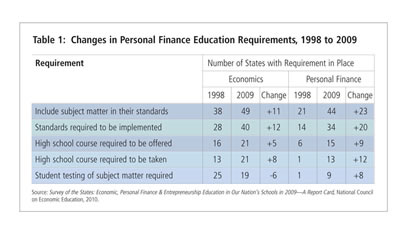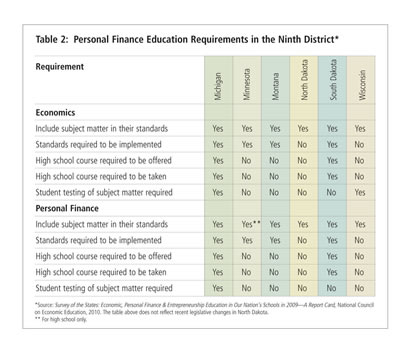Recent research on the effectiveness of personal financial education offered in high schools is limited and far from conclusive, but the studies that have been completed so far suggest important and positive short-term and long-term effects of the training.1/ In particular, evidence of short-term effects comes from a late 1990s study of students exposed to the High School Financial Planning Program® curriculum. Researchers concluded that almost half of the students in the study reported increases in their financial knowledge, with the biggest changes occurring in the areas of consumer credit, car insurance, the time value of money, and tracking expenses.2/
At least one study based on financial and demographic data collected in 1995 from a national sample of 2,000 individuals (aged 30 to 49) suggests that there are long-term benefits to financial education as well.3/ The study found that adults who attended high school at a time when their states mandated financial literacy training generally save more, accumulate more wealth than other adults, and have a higher net worth. These sorts of findings have encouraged many states to add personal finance content to their curricula and adopt additional requirements.
According to a survey that the National Council on Economic Education (NCEE) has conducted every two or three years since 1998, states have steadily added requirements for both economic education and personal finance education in recent years.4/ (See Table 1.) The survey tracks several different categories of educational requirements. First, it identifies which states have adopted content standards for teaching the subject in question. Next, it identifies which states require that the adopted content standards be implemented by local school districts. The survey then identifies which states require high schools to offer a course on the topic, which states require all high school students to take such a course as a condition of graduation, and which states require that students be tested on their knowledge of the subject.
The latest NCEE survey, which was conducted in 2009, shows that almost all states have now adopted content standards for economics education and require implementation of the standards as part of their curriculum. In addition, 21 states currently require students to take an economics course before graduation. States have also added more personal finance training requirements. For personal finance, the number of states that have adopted content standards has doubled, while the number of states requiring implementation of content standards has increased from 14 to 34. In addition, 13 states now require students to complete a personal finance course as a condition of graduation, a substantial increase since 1998 when only one state had that requirement.
A snapshot of current requirements in the six states that lie wholly or partly in the Ninth Federal Reserve District (Michigan, Minnesota, Montana, North Dakota, South Dakota, and Wisconsin) reveals that all six require the adoption of content standards for both economic and personal finance education. (See Table 2.) However, that is the only feature from the study that all the states share. Michigan's educational requirements are by far the most comprehensive with regard to both economic and personal finance training. South Dakota mandates nearly all of the requirements, except for requiring testing for students. While all other District states require the adoption of standards and some require implementation of those standards, most of them do not mandate that a course be offered or require that it be a part of graduation requirements.
While the trend from 1998 to 2009 has been for more states to either adopt standards or add new educational requirements for both economics and personal finance, it is unclear if this trend will continue over the coming decade. Nevertheless, for those who advocate for increasing such educational mandates, the recent financial turmoil and economic downturn have renewed hope that their efforts to expose the next generation of consumers, who are currently in the K-12 education system, to the basic concepts of personal finance and economics will remain on course.
North Dakota adds personal finance to high school graduation requirementsAt the end of the 2009–2010 legislative session, the North Dakota Legislative Assembly added personal finance to the state's educational requirements for public high school graduation. Introduced by Representative John Wall, a former high school journalism and English teacher from Wahpeton, the bill mandated that the "concepts of personal finance" should be included in the high school curriculum beginning on July 1, 2010. In creating this new mandate, state legislators were responding to the recent market turmoil and credit crisis and to a greater awareness of the need for students to have at least a basic level of financial skills and knowledge before leaving high school. The new law requires that "each school district shall ensure that its curriculum for either economics or problems of democracy includes the exposure of students to concepts of personal finance." Specifically, the law calls for the following issues to be covered in either of these high school classes:
A separate proposal to require a specific personal finance course in high school did not pass, mostly due to the concern that it would overburden school districts and teachers with an additional course requirement. Passing new education standards may be the easy part compared to the work involved in implementing these standards in North Dakota's classrooms. After passage of the new requirements, the state had a short timeline and limited budget to prepare school districts for the change. The North Dakota Department of Public Instruction immediately organized a personal finance committee that developed a new curriculum and gathered instructional resources for teachers. The committee consisted of representatives from the private sector, public education, state government, and the state's financial services industry. A key to the success of the implementation efforts will be the help provided by local finance professionals and members of the state's Jump$tart Coalition for Personal Financial Literacy, who are assisting with classroom delivery of the training. In the end, all of this hard work will help prepare next year's graduating class to deal with the complexities of our modern financial system. |
1/ Examples of this research include Lewis Mandell, The Impact of Financial Education in High School and College on Financial Literacy and Subsequent Financial Decision Making, presented at the American Economic Association Meetings in San Francisco, Calif., January 4, 2009; and Michael Gutter, Financial Management Practices of College Students from States with Varying Financial Education Mandates, National Endowment for Financial Education, 2010.
2/ Sharon M. Danes, Catherine A. Huddleston-Casas, and Laurie Boyce, "Financial Planning Curriculum for Teens: Impact Evaluation," Financial Counseling and Planning, Volume 10(1), 1999.
3/ Douglas Bernheim, Daniel M. Garrett, and Dean M. Maki, "Education and Saving: The Long-Term Effects of High School Financial Curriculum Mandates," Journal of Public Economics, 80, 2001.
4/ Survey of the States: Economic, Personal Finance & Entrepreneurship Education in Our Nation's Schools in 2009—A Report Card, National Council on Economic Education, 2010.
Michael works to advance the economic well-being of Indian Country and low- to moderate-income individuals, households, and communities. He has conducted research and published articles on affordable housing, community development corporations, homeownership disparities, and foreclosure patterns and mitigation efforts.







